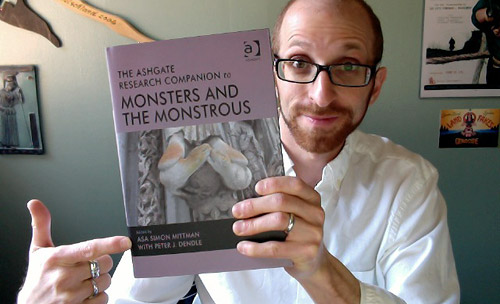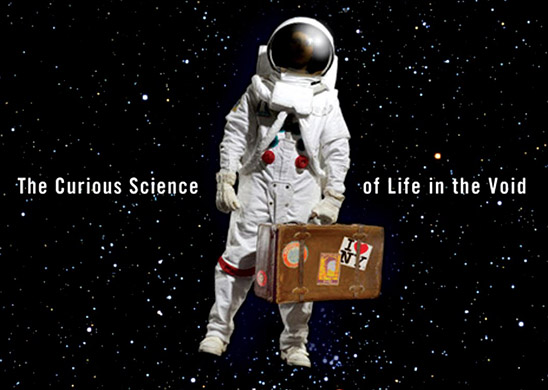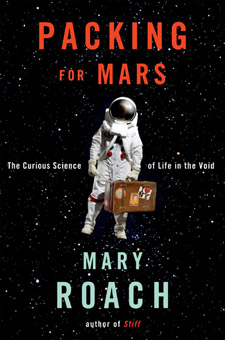In this week’s eSkeptic:

NEW ON MICHAELSHERMER.COM
The Dangers of Keeping an Open Mind
In Michael Shermer’s September 2013 ‘Skeptic’ column for Scientific American, he discusses why great scientists make great mistakes, reminding us of some of the biggest blunders that have been made.

NEW FROM DANIEL LOXTON ON SKEPTICBLOG.ORG
Abominable Science! Media Round Up
Daniel Loxton gathers links to a number of the early media reviews and discussions of Abominable Science, including Nature, The Wall Street Journal, and The Times of London.


More Map Monsters
Medieval Art expert Asa Mittman discusses his love of monsters, the kinds of monsters that populate medieval land maps, and the persistent practice of monsterization as a cultural method for labeling “out-groups” in human interaction.

About this week’s eSkeptic
In this week’s eSkeptic, George Michael reviews Mary Roach’s book, Packing for Mars: The Curious Science of Life in the Void (W.W. Norton & Company, 2013, ISBN: 0393068471).
George Michael received his Ph.D. from George Mason University’s School of Public Policy. He is an associate professor of criminal justice at Westfield State University in Massachusetts. Previously, he was an associate professor of nuclear counter-proliferation and deterrence theory at the Air War College in Montgomery, Alabama. He is a veteran of both the U.S. Air Force and the Pennsylvania Air National Guard. He is the author of five books, including The Enemy of My Enemy: The Alarming Convergence of Militant Islam and the Extreme Right, Willis Carto and the American Far Right, and most recently, Lone Wolf Terror and the Rise of Leaderless Resistance which was published by Vanderbilt University Press in 2012. In addition, his articles have been published in numerous academic journals.
Martian Chronicles
a book review by George Michael
To date, the Space Age reached its apogee on July 20, 1969, when the Apollo 11 crew landed on the moon. Mars seemed to be the next logical destination, but the age of exploration quickly gave rise to the age of experimentation as both the U.S. and Russian space programs focused on low-orbit missions and stints on space stations. But, new hope for reaching Mars came last year, when Dutch entrepreneur Bas Lansdorp announced his intention to establish a human colony in 2023. According to the plan, the intrepid pioneers will fly on a one-way trip to Mars where they will begin building a permanent settlement. Every two years, a new set of four astronauts would join them. Funding would come in part from a global reality television program in which candidates for the expedition would be selected. In Packing for Mars: The Curious Science of Life in the Void, Mary Roach, a journalist with unusual research interests (death, corpses and the afterlife, the science of sex, how food is digested, etc.), takes a close look at the challenges facing those spacefarers headed to the red planet.
As Roach notes, humans are difficult and expensive to send into space. Therefore, the first spacefarers were not humans, but test animals. She recounts the vital role that animal subjects played in the early space program. For the early flights, piloting duties were light to nonexistent. Inasmuch as the first space capsules were more akin to bullets than rockets, nonhumans were good candidates for these missions. Whereas the National Aeronautics and Space Administration (NASA) launched monkeys and chimpanzees on its rockets insofar as primates were physiologically similar to humans, the Soviet program preferred to send dogs into space, believing that canines were less excitable. A dog named Laika became the first living creature to orbit the Earth, but alas, there was no plan or means to bring her safely back home. The first of the great apes to be launched into outer space—Ham the Astrochimp—was more fortunate. Upon his successful return to Earth, he was feted as a national hero, appearing on the cover of Life magazine in his flight suit. Some of his fans even sent their copies of Life with requests for Ham’s “autograph,” which consisted of an ink print of his hand. On a practical level, his lever-pushing performance demonstrated that such tasks could be carried out in space. In order to beat the Soviets to the Moon, NASA once considered sending a chimp on a one-way mission; however, even if successful, the agency would have had to deal with the public relations fiasco of a dead chimpanzee hero.

Order the hardback
Order the paperback
Order the Kindle Edition
Order the audio CD
Order the Apple iBook
The first human astronauts were chosen for their “right stuff,” viz., their temerity and charisma. From the earliest days of the space program, the astronauts were looked upon as exemplars of their respective societies. Assumed to be rugged individualists, the early astronauts could not depend on anyone but themselves and a small crew. But in the contemporary Space Age, crews are larger and more diverse and missions are longer. This has changed the group dynamics on board spaceflights. As Roach explains, what was the “right stuff” for the Mercury era could now very well be the “wrong stuff” for long duration missions. Increasingly, astronauts have to be persons who play well with others. In the early years of spaceflight, the most pressing issues concerned life support, the human-machine interface, and the optimization of human performance to ensure mission success. But gradually over the years, a shift from a purely “displays and knobs” orientation to a more holistic approach, which involved project managers, engineers, and behavioral researchers, began to take hold. As more and more doctors, biologists, and engineers are among the ranks of the spacefarers, Roach opines that “astronauts these days are as likely to be nerds as heroes.” Or…the heroes are the nerds.
The early space psychologists did not worry much about astronauts getting along with each other on flights insofar as their missions lasted only a few hours, or at most, a few days. Furthermore, the first astronauts flew solo. The overriding concern at the time was what effect the silent, black vacuum of space would have on the spacefarers. Claustrophobia and solitude were the two most salient conditions on the minds of space psychologists. But there were salutogenic (enhancing mental and physical wellbeing) effects as well. Some astronauts felt the experience in space euphoric, commenting that they felt nearer to God. NASA was concerned not so much about euphoria itself, but whether this elation could overtake good sense. On a long mission to a distant destination it could be difficult to anticipate how much astronauts will miss the world when they are deprived of it for an extended period of time. The “Earth-out-of-view” problem could arise with astronauts on a trip to Mars, in which the home planet will be reduced to an insignificant-looking dot in space.
There is concern that NASA, which has historically downplayed psychological problems, is unlikely to spend much time and resources to investigate those issues. Although access to psychologists is available during missions, crewmembers are usually reluctant to make use of it. Astronauts are understandably fearful that even the slightest sign of a psychological malady will disqualify them from flying. This reluctance is dangerous because if someone on a spacecraft is reaching the breaking point it is important for ground control to know about it. The faintest possibility that a space mission would be compromised by psychological factors could be a public relations disaster for NASA.
To get a better understanding of the rigors of space travel, Roach visited numerous simulation and test sites. At the Mars Surface Simulator—Mars 500—located at the Institute of Biomedical Problems in Moscow, she interviewed scientists who examined the psychological effects on subjects living in an isolated, confined environment with no privacy. On board NASA’s C-9 plane, she experienced weightlessness during a parabolic flight. To gain a better understanding of the long-term effects of living in zero gravity on the human body, she talked to scientists and subjects at a NASA-funded bed-rest study at the Flight Analogs Research Unit at the University of Texas Medical Branch in Galveston. She visited a crash test lab at the Transportation Research Center in Ohio where NASA conducts experiments on cadavers to test the effect of severe g-forces on humans. To prepare for another mission to the moon, NASA uses the HMP (Haughton-Mars Project) at Devon Island in Canada. Granted access to the site, Roach had the chance to observe the Small Pressurized Rover—an orange Humvee—traverse the craterous terrain that resembles the moon.
As Roach points out, everything we take for granted on Earth must be rethought, relearned, and rehearsed when venturing into space. Inasmuch as humans have evolved for life on Earth, they are not accustomed to living in space. Initially, weightlessness can be an exhilarating experience; however, the novelty quickly wears off and floating astronauts soon dream of walking. Astronauts often experience motion sickness which can lead to vomiting—a problematical situation in a gravity-free environment. In fact, NASA space helmets are built with air channels that directly flow down over the face at six cubic feet per minute so that vomit will blow down away from the face and into the body of the suit.
Living in a near-zero gravity situation for a protracted period can have serious health consequences. Currently, the practical limit on weightlessness has been about six months. Weightlessness effects circulation resulting in increased blood volume in the upper half of the body, which also happens to be the place where the body’s blood sensors are located. When astronauts are in space, the sensors misinterpret this effect as a surplus of blood, which causes the body to reduce its production. As a result, astronauts in space make do with 10 to 15 percent less blood than they do on Earth.
The most serious consequence of weightlessness, though, is that bones thin and muscles atrophy. Although muscle mass is regained in a matter of weeks, bones take three to six months to recover. In fact, some studies suggest that the skeletons of astronauts of long duration missions never quite recover. According to the research of Dennis Carter of Stanford University, astronauts on a two-year mission to Mars could expect to eventually lose from one-third to one-half of their bone mass in their lower bodies—a situation not unlike a paraplegic. An astronaut returning from a mission to Mars could very well risk snapping a bone when stepping out of the capsule into Earth’s gravity. Not only must astronauts acclimate to weightlessness, they must also deal with high g-forces of acceleration during launch and deceleration during reentry.
Provisioning space crews has always been challenging. The first space food was not unlike baby food; astronauts had to suck their meals out of tubes. Carbonated drinks are not feasible in space because the bubbles don’t rise to the surface; instead, there is only a foamy froth. In recent years, the quality of the space food has improved as meals no longer have to be compressed or dehydrated. Maintaining good body hygiene is difficult in space. Showers are unavailable; instead, astronauts wipe themselves with moistened towels and rinseless shampoo. Although clothes are normally good absorbers of sebum (the oil produced by glands) and sweat, when astronauts are unable to change garments for long durations, the garments begin to decompose. Excretion can be difficult because in a weightless environment, fecal material never becomes heavy enough to break away and drop down on its own.
For long duration missions, sexual concerns will become more pronounced. Some space managers have even recommended that a Mars crew should be composed of couples in order to ease the tension that could build up during a long mission. There is much uncertainty how traveling in space would influence conception and pregnancy. What biological perils could await an embryo conceived in space? Beyond the protection of the Earth’s atmosphere, cosmic and solar radiation levels rise significantly. Dividing cells are extremely sensitive to radiation, which could increase the risk of mutation and miscarriage.
Sending humans to Mars is an enormously expensive proposition. For space engineers, sending robots seems more practical than sending humans as the former requires no water, oxygen, or food supply. Moreover, there is no need to worry about interpersonal issues that might arise with a human crew. In recent missions, robotic probes have demonstrated great potential. In August of 2012, an automated motor vehicle—the Curiosity rover—began exploring and conducting experiments on the Gale Crater on Mars and sending back exciting results. As Roach points out, however, robotic landers do not capture the public’s imagination in the same way as real flesh-and-lood astronauts. What is more, humans possess intuition, a trait that has yet to be duplicated in artificial intelligence. Humans can draw upon a vast catalogue of experiences that they have accumulated over a lifetime in order to make quick decisions. Without the public’s interest and support, it is all the more difficult for NASA to secure funding. In short, for NASA there will be “no bucks without Buck Rogers.”
To Roach, the tough question is not so much “Is Mars possible?” but “Is Mars worth it?” A mission to Mars, she avers, would be the ultimate reality TV. While conceding that the money on such a mission could be better spent on Earth, she counters “But would it?” Since government funds are often squandered, she reasons, why not squander some more on Mars? But with an estimated price tag of anywhere between a 100 billion to a trillion dollars, this proposition would seemingly be a hard sell in an increasingly tight fiscal environment. Nevertheless, according to a recent poll, 75 percent of those Americans surveyed agreed that NASA’s budget should be substantially increased in order to fund this endeavor. (Jason Koebler, “Poll: Americans Overwhelmingly Support Manned Mars Mission,” U.S. News and World Report, February 11, 2013.) Perhaps we will soon have the scientific capabilities, public support, and political will for the next major achievement of the Space Age. ![]()









